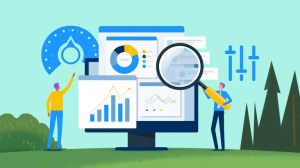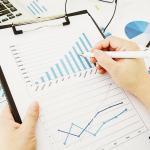Time is a precious resource. We all want to make the best use of the time we have, especially in business. That’s why focusing on sales efficiency is so important. This metric tracks how long it takes for your sales team to turn prospects into paying customers. In other words, it’s a measure of how quickly you can generate revenue.
You need to know your team’s sales efficiency so you can keep your business on track. Read on to learn what sales efficiency means, how to calculate it, and ultimately improve.
What you’ll learn:
- What is sales efficiency?
- Why sales efficiency is important
- How to calculate sales efficiency
- What is a good sales efficiency ratio?
- Sales productivity vs. sales efficiency
- 8 ways to improve sales efficiency
What trends drive sales productivity today?
We believe that business is the greatest platform Get the State of Sales Report to discover AI and productivity insights from 5,500 sales professionals.



What is sales efficiency?
Very simply, sales efficiency tracks how quickly your business can generate revenue during a specified period of time. It measures how fast your sales reps can convert prospects into leads, and then turn those leads into customers.
If you want to be more efficient, you need to make more sales with fewer resources in a shorter amount of time. All spent resources are measured against the time spent to produce results — and the resulting ratio shows the efficiency of your sales team.
When you measure sales efficiency, it reveals the reps who are underperforming. Then, you can offer those reps support, guidance, and training — and if all goes well, their sales efficiency will improve.
Why sales efficiency is important
Most sellers are missing their sales targets — more than 70%, according to the latest State of Sales report. That’s almost 3 of 4 salespeople who fail to hit their sales quotas. And when you, as a sales leader, have a situation where only the top 28% of your people are reaching their goals, you have to ask yourself: “What are these other reps doing?”
When you understand sales efficiency, you’ll see whether your methodologies, process, and overall strategy is sustainable.
Let’s assume you see that your underperforming reps are spending time working deals that never closed. Over two quarters, perhaps they produced just two closed deals. Meanwhile, a top rep who consistently hits quota closed seven deals. Clearly, there’s something inefficient going on with that underperforming rep. If you can get to the heart of the problem, you can work to find a solution.
How to calculate sales efficiency
Sales efficiency is calculated by dividing the gross revenue generated by the costs incurred by the sales team over a specific time period. These costs can include things such as salaries, expenses, and training. This calculation shows how efficient your sales strategies are over time. It helps you understand the impact of the money spent selling your products or services.
Here is an illustration of the formula:
You can use the formula to review the entire sales pipeline or measure individual deals. Reviewing the entire sales pipeline is useful because it shows how much your business is growing in proportion to every dollar spent on sales. For individual sales, it shows how wisely a team member is using resources to close deals. In many cases, you’ll want to review both metrics because larger deals will require more time and resources, while smaller deals will not.
What is a good sales efficiency ratio?
Now, that formula gives you a basic understanding of how to calculate sales efficiency, but it doesn’t tell the whole story. The sales efficiency metrics of the total pipeline can be a bit misleading; certain variables will affect the formula. For example, some reps may have favourable territories or other conditions that may affect their win rate. You have to look at the big picture.
Other sales metrics that impact a sales team’s performance include:
- Leads: How are your reps acquiring customers? Understanding the methods they use to get leads — and the number of leads they generate — are key to calculating the effectiveness of your sales reps.
- The average revenue per customer (ARPC): How much money are you earning with a customer over a specific period of time? The ARPC measures the profitability of your product or service based on the money generated by each customer.
- Customer lifetime value (CLV): How does your business retain customers? The CLV shows how much income you can expect from a customer over the course of your relationship.
- Year-over-year growth (YOY): How close is your business to reaching its long-term goals? YOY compares your company’s current annual financial gain with the previous year’s.
Sales activity completion rates: How many sales are your reps closing? With sales activity completion rates, you can see how productive your sales reps actually are.
Sales productivity vs. sales efficiency
While sales productivity and sales efficiency may sound like more or less the same thing, they focus on different aspects of the sales process:
- Sales productivity measures the output of a sales team or individual salespeople relative to the input of resources. These resources include time, effort, and money. It focuses on end results and the overall output as compared with the input. Some of the key metrics include:
- Revenue per salesperson
- Number of deals closed per salesperson
- Customer acquisition rate
- Sales growth rate
- Sales efficiency measures how effectively a sales team or individual uses their resources — things such as time, budget, and tools — to achieve sales goals. Key metrics include:
- Conversion rate
- Sales cycle length
- Cost per acquisition
- Ratio of successful to unsuccessful sales calls
Essentially, sales productivity is about the quantity of results achieved, while sales efficiency focuses on the effectiveness of the process to achieve those results.
Think of a company that sells subscriptions to a high-end photo editing tool. It has two sales teams, one in Los Angeles and one in New York. Team Los Angeles closed 50 deals in a month, generating $1 million in revenue.
Team New York, meanwhile, is using conversational AI in their Customer Relationship Management (CRM) software. They’re able to work more efficiently and spend more time focusing on their customers, which increases their average deal rate. Because of this extra attention, Team New York closed 50 deals during the same period but generated $1.5 million in revenue.
While these two teams closed an equal number of deals, they are not equally productive. Team New York shows a higher sales efficiency because they’re achieving a better result with fewer resources.
8 ways to improve sales efficiency
The best way to improve sales efficiency is to improve sales velocity — or just how quickly a rep can close a deal.
Sales velocity speeds up the sales process, enabling faster revenue generation and better cash flow management. It boosts the productivity of your sales team by allowing them to handle more deals in less time. Monitoring sales velocity can also help you accurately track the time it takes for your team to close deals. This can reveal potential roadblocks in your sales process that can jeopardise sales targets.
Other ways to improve sales efficiency include:
1. Set clear sales targets
Sales goals provide a clear direction for the sales team, and that kind of focus improves efficiency. Incentivise your team by offering bonuses and commissions. S.M.A.R.T. goals increase productivity and improve performance.
2. Streamline the sales processes
First, you need to define a clear sales strategy, clearly outlining the process of moving a lead through the sales pipeline. This includes creating a structure of prospecting, qualification, presentation, negotiation, closing, and follow-up. Once that structure is in place, you can streamline the sales process by managing customer data, tracking interactions, and automating tasks with customer relationship management (CRM) software.
3. Take advantage of technology
Using a sales CRM tool makes it easy to boost your sales team’s efficiency and increase sales productivity without hiring additional staff. A CRM platform combined with sales tools can turbocharge efficiency by automating lead nurturing, follow-ups, and scheduling. It can also automate repetitive tasks and provide valuable insights into customer behaviour. For example: A software company decides to implement a sales automation system to streamline its sales process. Before automation, the sales team could handle 50 leads per week. After automation, they could handle 100 leads per week with the same number of resources.
4. Implement sales performance metrics
Consistently hitting benchmarks improves efficiency. One way to measure how well your team is doing is to track key performance indicators (KPIs). Sales KPIs include conversion rates, average deal size, and sales cycle length. These performance metrics identify areas of strength — and what could use improvement.
5. Encourage collaboration
Teamwork makes the dream work. Fostering a culture of collaboration among sales, marketing, and other departments will go a long way toward improving sales efficiency. And reviewing sales calls with generative AI-powered call summaries can make for more effective coaching.
6. Enhance personalisation
Personalisation drives performance and makes for better customer outcomes. And companies with faster growth drive 40% more of their revenue from personalisation than their not-as-quick counterparts, according to research by McKinsey. Make it easier for reps to personalise their communications with prospects and improve efficiency by providing tools that they can use to quickly customise pitches.
7. Effective sales coaching
Your team will be more efficient if your managers actively support them. Review sales calls to find areas that need improvement. Develop strategies to help reps identify unproductive deals early in the sales process. Share success stories and case studies highlighting the positive effects of improved sales efficiency. All of that will foster a culture of accountability and improvement.
8. Provide sales training
Reps perform better when they feel like they’re in control of their own destiny. Invest in sales training programs — such as a course designed to double sales results within 90 days — to improve the efficiency of reps’ selling skills, product knowledge, and customer engagement techniques.
Sales efficiency for the win
Many sales reps are foiled by spending most of their time performing rote tasks when they should be doing what they do best — selling. By taking advantage of the automation in CRM software, sales reps can increase their productivity. And when you amp up productivity, you increase sales efficiency. When you’re more efficient, you’ll bring in more profit for your company — and your reps will bring home fatter paychecks.
State of Sales has landed
Get the State of Sales Report to discover AI and productivity insights from 5,500 sales professionals.


























